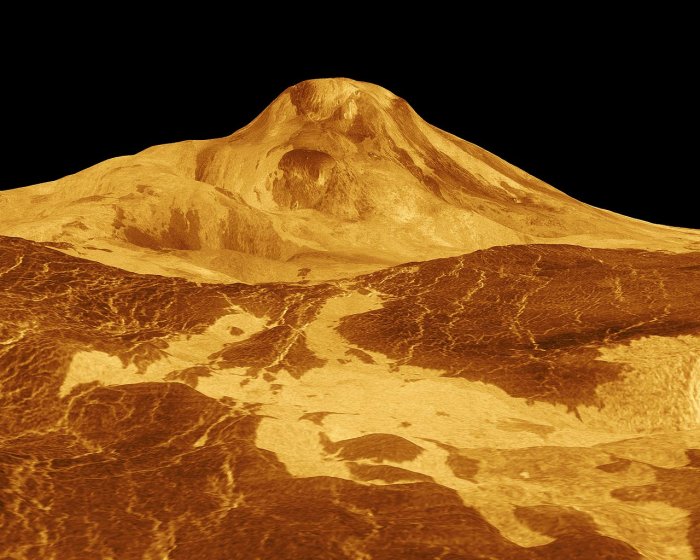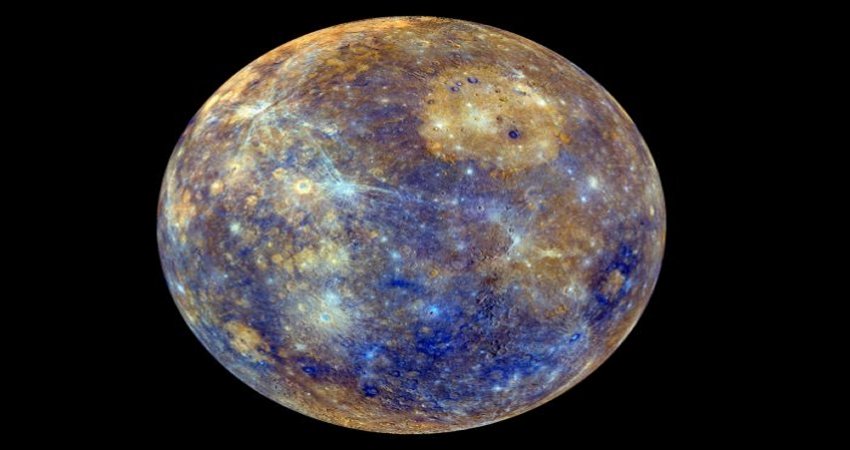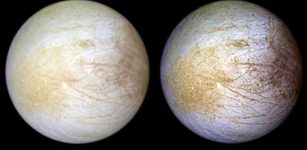Evidence Of Recent Volcanic Activity On Venus
Eddie Gonzales Jr. – MessageToEagle.com – Venus has often been called Earth’s sister planet because of their similarities. Both planets are terrestrial (made up of silicate rocks), similar in size, mass, and gravity. Venus probably has a similar structure to Earth, with a crust, mantle, and core but there are also many differences.
 The 8-km-high volcano Maat Mons is displayed in this perspective view of the surface of Venus, with the vertical scale multiplied by 22.5. Based on Magellan radar images. Image credit: NASA – Jet Propulsion Laboratory
The 8-km-high volcano Maat Mons is displayed in this perspective view of the surface of Venus, with the vertical scale multiplied by 22.5. Based on Magellan radar images. Image credit: NASA – Jet Propulsion Laboratory
Although our “sister planet” lies within the habitable zone, it is not friendly. Its surface is inhospitable due to the planet’s greenhouse effect that causes the temperatures at its surface to reach 864 degrees Fahrenheit (462 degrees Celsius), making Venus the hottest planet in the entire Solar System.
Having consistently extremely high temperatures, Venus has no surface water. On the other hand, it has more than 1,500 volcanoes, many of which are more than 100 kilometers across. Most of the volcanoes are extinct, but some researchers believe that there has been recent volcanic activity.
New research shows that Venus could be volcanically active today – making it the only planet in our solar system, other than Earth, with recent eruptions, researchers say.
According to new data, lava flows on Venus may be only a few years old, which would imply that the planet does have active volcanoes.
“If Venus is indeed active today, it would make a great place to visit to better understand the interiors of planets,” Dr. Justin Filiberto, the study’s lead author and a Universities Space Research Association (USRA) staff scientist at the Lunar and Planetary Institute (LPI), said in a press release.
“For example, we could study how planets cool and why the Earth and Venus have active volcanism, but Mars does not. Future missions should be able to see these flows and changes in the surface and provide concrete evidence of its activity.”
Radar imaging from NASA’s Magellan spacecraft in the early 1990s revealed Venus, our neighboring planet, to be a world of volcanoes and extensive lava flows. In the 2000s, the European Space Agency’s (ESA’s) Venus Express orbiter shed new light on volcanism on Venus by measuring the amount of infrared light emitted from part of Venus’ surface (during its nighttime).
These new data allowed scientists to identify fresh versus altered lava flows on the surface of Venus. However, until recently, the ages of lava eruptions and volcanoes on Venus were not well known because the alteration rate of fresh lava was not well constrained.
Dr. Filiberto and his colleagues recreated Venus’ hot caustic atmosphere in the laboratory to investigate how the observed Venusian minerals react and change over time.
Their experimental results showed that an abundant mineral in basalt — olivine — reacts rapidly with the atmosphere and within weeks becomes coated with the iron oxide minerals – magnetite and hematite. They further found that the Venus Express observations of this change in mineralogy would only take a few years to occur.
Written by Eddie Gonzales Jr. – MessageToEagle.com Staff











